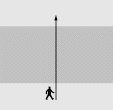
The Road Crossing Code is a guide for all pedestrians. It is a guide for crossing all roads, including the less busy roads in housing estates. You should follow the Code whenever you need to cross or step onto a roadway even if you are using a pedestrian crossing.
If you are responsible for a child, also see Chapter 9 on advice for children.
| There are six basic steps that need to be understood and applied: |  |
||
| Step 1 | -- | First find a safe place to cross, then stop. | |
| Step 2 | -- | Stand on the pavement near the kerb. | |
| Step 3 | -- | Look all around for traffic and listen. | |
| Step 4 | -- | If traffic is coming, let it pass. Look all around again. | |
| Step 5 | -- | When there is no traffic near you, walk straight across the road. | |
| Step 6 | -- | Keep looking and listening for traffic while crossing. | |
Step 1 - First find a safe place to cross, then stop
It is safer to cross a road using nearby footbridges, subways, ʻZebraʼ or ʻGreen manʼ crossings, or where there is a police officer, traffic warden or school crossing patrol controlling a crossing place.
If you cannot find any such crossing place, choose a place where you can see clearly along the roads in all directions, a place where you can also see any traffic when it is a long way off, and the drivers can also see you clearly. Keep walking on pavement until you find a safe place to cross.
Step 2 - Stand on the pavement near the kerb
You should stop before crossing even if you think nothing is coming, just to be sure it is absolutely safe. You can see things much better if you stop and have a good long look.
Do not stand too near the edge of the pavement. Stop a little way back from the kerb - where you will be away from traffic, but where you can still see if anything is coming.
If there is no pavement, stand back from the edge of the road but where you can still see traffic.
Step 3 - Look all around for traffic and listen
Look carefully along every road because traffic may be coming from all directions. And listen too, because you can sometimes hear traffic before you can see it. Look out for vehicles and note which way they are moving, and how fast. Look out for stationary vehicles that may start to move.
Look out for motor cycles and cycles as they are not so easy to be seen as cars because of their relatively small size. A cycle may be less easily noticed because it approaches silently, while a motor cycle may take you by surprise because it accelerates more quickly than other traffic. Listening is usually helpful in detecting motor cycles. However, electric/hybrid vehicles including motor cycles may operate very quietly. You need to look out for them in addition to listening.
If it is noisy around you, particularly near construction works, it may be difficult to hear, so take extra care when looking out for traffic.
Step 4 - If traffic is coming, let it pass. Look all around again
If there is traffic approaching, let it pass. Then look around and listen again to make sure no other traffic is coming.
You have to decide whether you can cross the road without putting yourself in danger. You have to judge the distance, speed, direction and actions of approaching vehicles with regard to the time you need to cross the road. Do not expect a driver to slow down for you. Look at vehicles to see if they are speeding up or slowing down, whether they are overtaking or changing lanes. Do not expect drivers will keep to the speed limit. Look for any signals from drivers, either hand signals, flashing indicators, or reversing lights that may warn of a driverʼs actions, but be careful in case the signal is an error or the driver forgets to signal. Look at the drivers to see if they have seen you.
Step 5 - When there is no traffic near you, walk straight across the road
When there is no traffic near you, it is safe to cross. If traffic is approaching in the distance, however, do not cross unless you are certain there is plenty of time. Even if traffic is a long way off, it may be coming very fast.
Allow more time to cross the road if you cannot see or hear very well due to poor visibility, noise or bad weather.
Decide the moment that the traffic situation is safe enough and will remain so to give you enough time to cross. Start walking after checking all directions that nothing new has happened.
Let the drivers know and react to your crossing.

When it is safe, walk straight across and not at an angle.
Cross the full width of the road in one go to the other side or to a traffic island. Do not cross one traffic lane at a time and do not wait in the middle of the road other than on an island.
Step 6 - Keep looking and listening for traffic while crossing
Walk so that you can keep looking and listening for traffic. Do not run. It is difficult to keep looking all around and to listen while you are running, and you may trip in front of a vehicle.
Keep looking and listening for vehicles that come into sight or come near you after you have started to cross and for any which you may not have seen earlier.
Do not loiter or move unnecessarily slowly when crossing the road, particularly on a pedestrian crossing. Do not carry out any other activities, such as eating, drinking, playing mobile games, using mobile phone, listening to any audio device or talking while crossing the road. Give all your attention to the traffic.
If something unexpected happens, depending on the circumstances and choices available, stop, walk on, or step back as quickly as possible. Try to let the drivers know what you intend to do. Use the centre line or the traffic lane line as a stopping place in an emergency.
If crossing in front of a vehicle that has stopped to allow you to cross, keep looking all around and listening as you walk and be sure to check traffic on the other lane when you reach the edge of the stopped vehicle, in case another vehicle does not stop and suddenly passes the stopped vehicle.
|
Stopping distances for vehicles |
|
 |
An important aspect in judging if it is safe to cross a road is the stopping distance. The distance a vehicle travels while a driver is thinking after he/she has seen and recognised danger and before he/she reacts is called the thinking distance. After the driver reacts by applying the brakes, it takes time for the vehicle to slow down and stop. The distance travelled during this time is the braking distance. The stopping distance is the thinking distance plus the braking distance. The faster a vehicle is travelling or the heavier it is, the longer the braking distance. On wet roads, all vehicles need a much longer braking distance. ( See page 54 for more information on stopping distance.) |